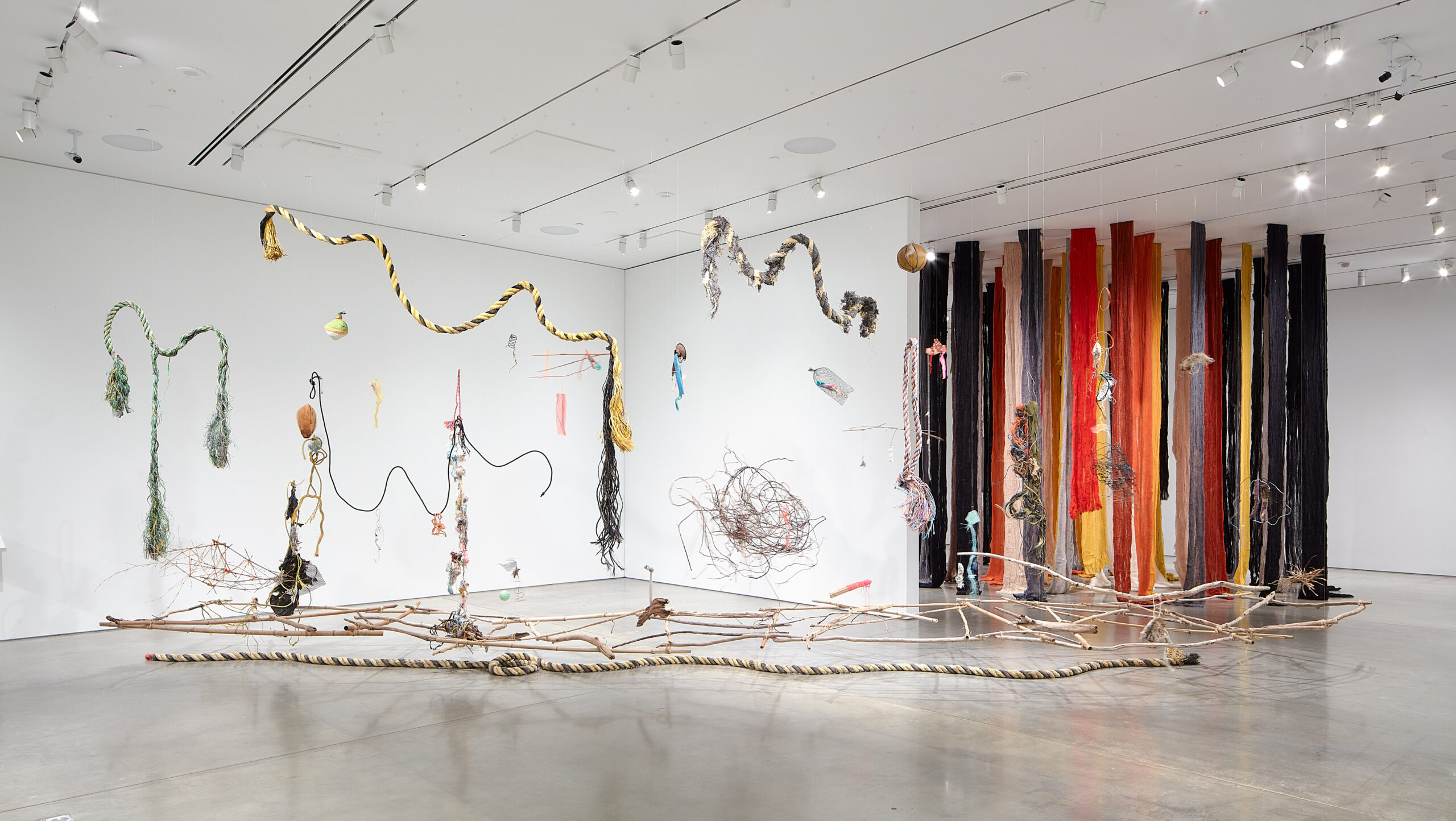
July 11–October 14, 2018 Photo by Impart Photography
Courtesy of BAMPFA
My work dwells in the not yet, the future potential of the unformed, where sound, weaving, and language interact to create new meanings.
In January 1966 I began creating precarios (precarious), installations and basuritas, objects composed of debris, structures that disappear, along with quipus and other weaving metaphors. I called these works “Arte Precario”, creating a new independent category, a non-colonized name for them. The precarios soon evolved into collective rituals and oral performances based on dissonant sound and the shamanic voice. The fluid, multi-dimensional quality of these works allowed them to exist in many media and languages at once. Created in and for the moment, they reflect ancient spiritual technologies—a knowledge of the power of individual and communal intention to heal us and the earth.
Precarious means prayer, uncertain, exposed to hazards, insecure. Prayer is change, the dangerous instant of transmutation.
Desire is the offering—the body is only a metaphor.
To respond is to offer again. An object is not an object. It is the witness to a relationship. In complementary union, two opposites collide to create new forms. Seeing and naming creates the space for the beauty of the exchange to unfold.
Weaving is awareness of the exchange.
The “quipu that remembers nothing,” an empty cord was my first precario (c. 1966).
*
My early works were not documented, they existed only for the memories of a few citizens.
History, as a fabric of inclusion and exclusion, did not embrace them.
(The history of the north excludes that of the south, and the history of the south excludes itself, embracing only the north’s reflections.)
In the void between the two, the precarious and its non-documentation established their non-place as another reality.
*
The poem is not speech, not in the earth, not on paper, but in the crossing and union of the three in the place that is not.
—Cecilia Vicuña

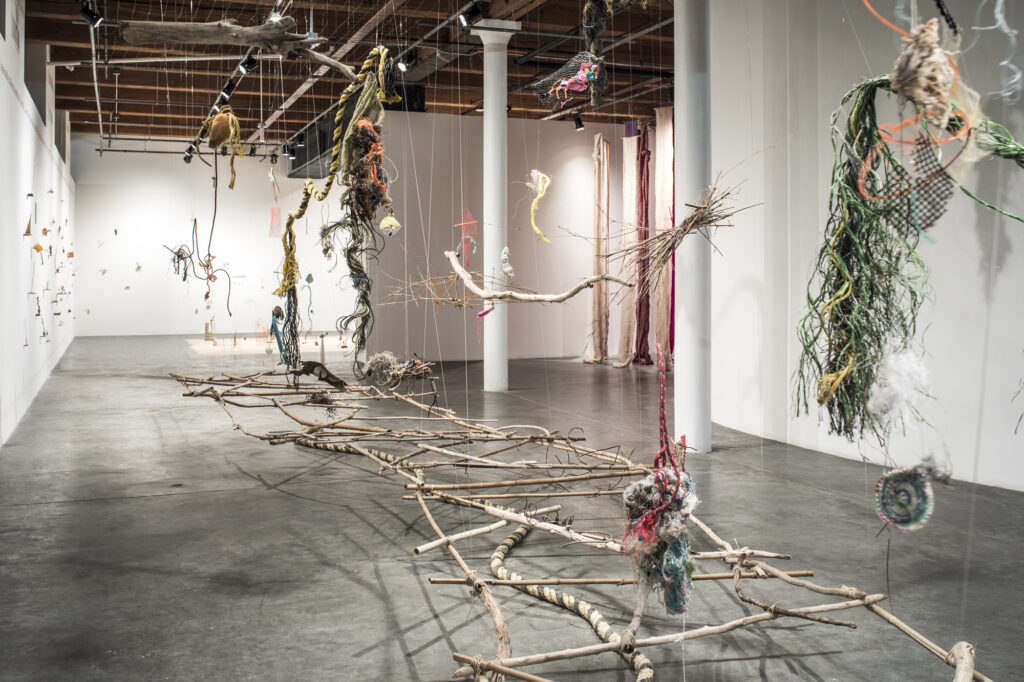
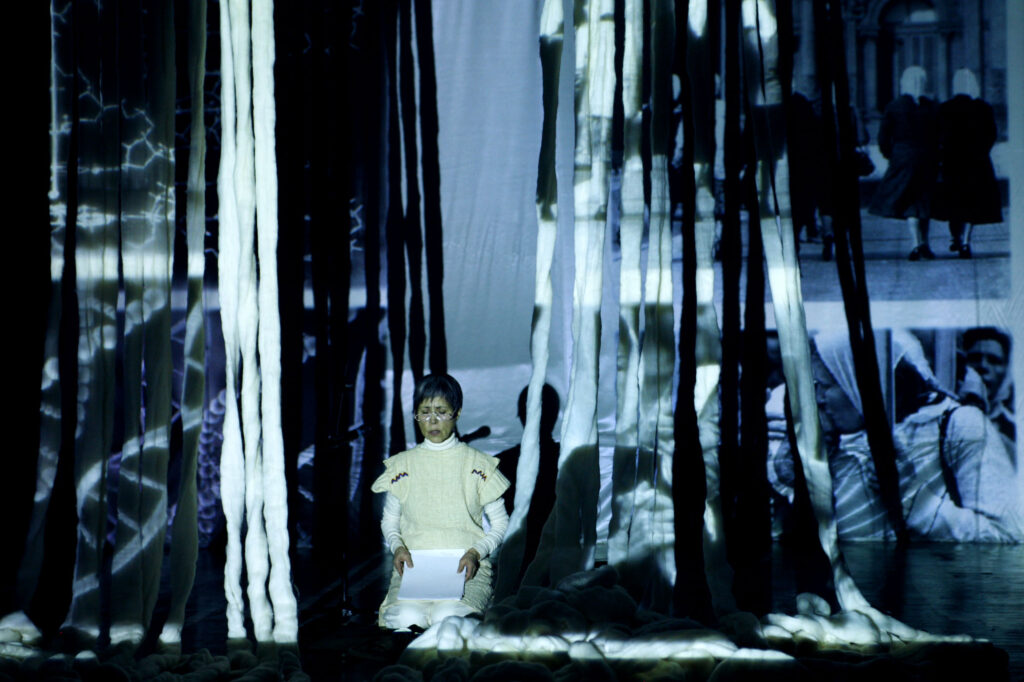
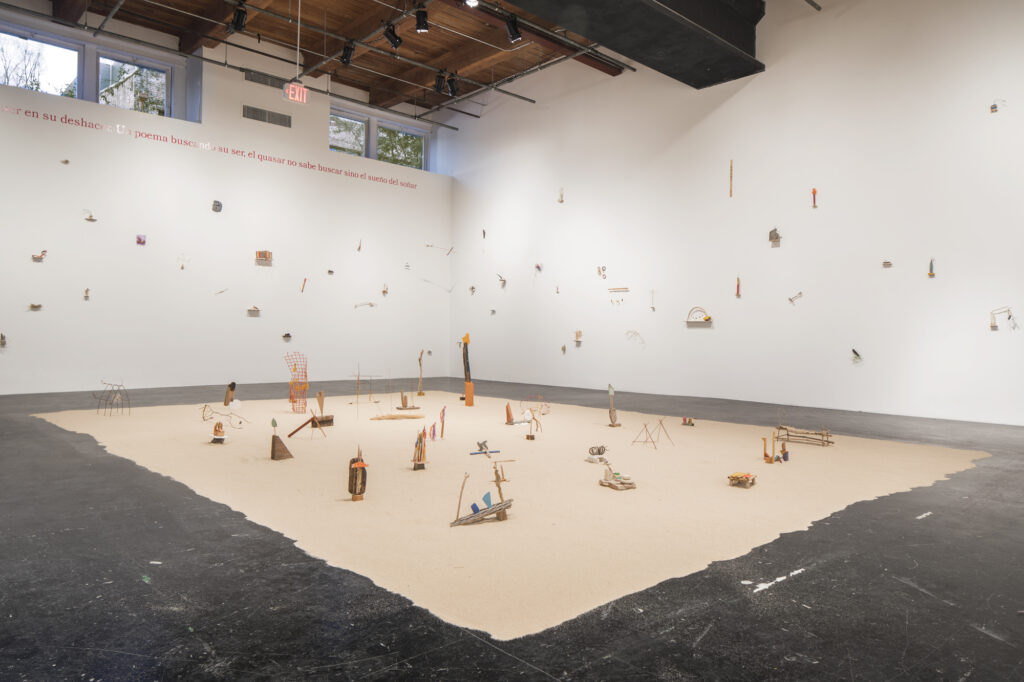
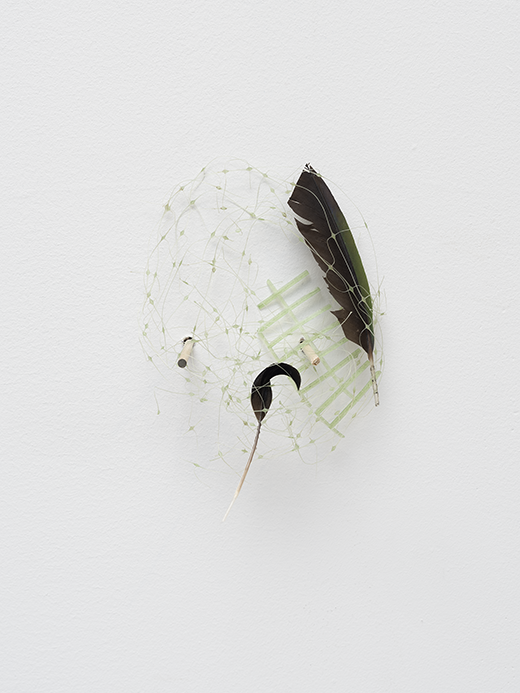
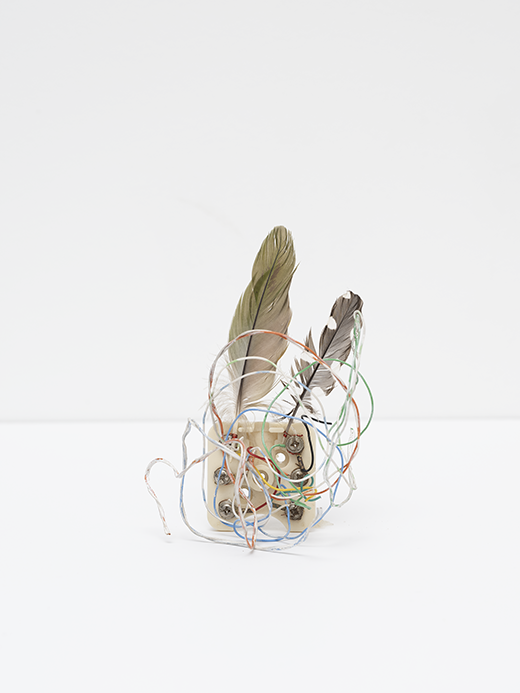
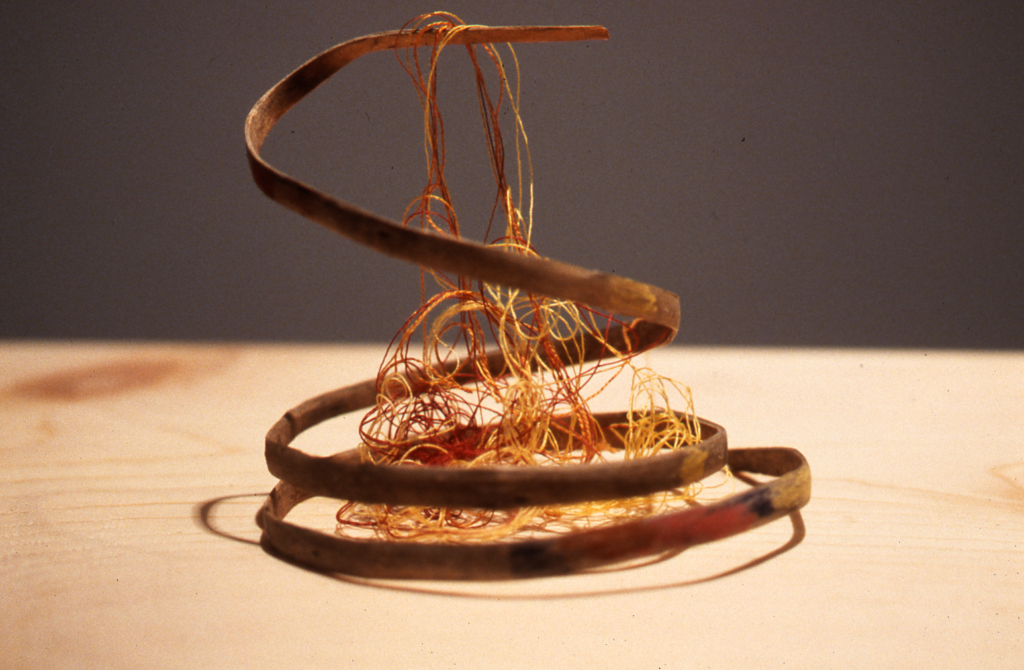
Cecilia Vicuña is a poet, artist, activist and filmmaker whose work addresses pressing concerns of the modern world, including ecological destruction, human rights, and cultural homogenization. Born and raised in Santiago de Chile, she has been in exile since the early 1970s, after the military coup against the president Salvador Allende. In London, she was a co-founder of Artists for Democracy in l974.
She coined the term “Arte Precario” in the mid-1960s in Chile, as a new independent and non-colonized category for her precarious works composed of debris, structures that disappear in the landscape, which include her quipus (knot in Quechua), envisioned as poems in space. Vicuña has re-invented the ancient Pre-Columbian quipu system of non-writing with knots through ritual acts that weave the urban landscape, rivers and oceans, as well as people, to re-construct a sense of unity and awareness of interconnectivity. These works bridge art and poetry as a way of “hearing an ancient silence waiting to be heard.” Her poetry and Palabrarmas (word-weapons) stem from a deep enquiry into the roots of language. Her early work as a poet in the 60’s was simultaneously celebrated by avant-garde poetry magazines as El Corno Emplumado, Mexico City (l961–1968), and censored and/or suppressed for many decades in Chile and Latin America.
Solo exhibitions of Vicuña’s work have been organized at a number of major institutions, including, most recently, the Tate Modern, London, United Kingdom (2022); Solomon R. Guggenheim Museum, New York, NY (2022); Museo de Arte Miguel Urrutia (MAMU), Bogotá, Colombia (2022); Centro de Arte Dos de Mayo (CA2M), Madrid, Spain (2021); CCA Wattis Institute for Contemporary Art, San Francisco, CA (2020); and Museo Universitario de Arte Contemporáneo, Mexico City, Mexico (2020). Her work has been featured in numerous group exhibitions and appears in major museum collections around the world.
Vicuña’s work was included in documenta 14, Athens and Kassel, 2017, and the 59th Venice Biennale, 2022, where she received the Golden Lion for Lifetime Achievement. The author of more than 30 volumes of art and poetry published in the United States, Europe, and Latin America, her most recent books are: Libro Venado, Direcciones, Buenos Aires, 2022; Sudor de Futuro, Altazor, Chile 2021; Cruz del Sur, Lumen Chile, 2020, Minga del Cielo Oscuro, CCE, Chile, 2020, and New & Selected Poems of Cecilia Vicuña, edited and translated by Rosa Alcalá, Kelsey Street Press, 2018.
An Ancient Silence Waiting to Be Heard
Video Transcript
It has been very moving to spend the day with you. And to feel that this synchronicity around water that Jolene noted and that everybody has not failed to mention. I want to begin with honoring what brings us together by reading to you a few words that I wrote five days ago, when it was time to think of you.
La sangre y el agua se encontraron en el lugar del exterminio. El lugar donde el agua desaparece. Blood and water met at the place of exterminium, (I don’t know how to translate that) where extermination takes place. The place where it takes place, the place where water disappears. It seems that those thoughts were already in synchronicity with the expectation of hearing and meeting you.
What I was thinking at the moment was, what on earth could I possibly tell you that I haven’t already performed 14,000 times or said 15,000 times throughout my long life? And yet the words seem to want to say something to you. And the first word I wrote here is: in Con Con pinté mi primera menstruación, In Con Con I painted my first menstruation. I was a 17 year old girl when that happened, and it’s like a foreboding, like an anticipation of my entire life’s work with water and menstruation and the unity of both.
So it turns out that shortly after that painting of menstruation, I created my first precario, my first precarious work in the beach of Con Con, the same place. This was in January of 1966. It was the first work for the sea to eat, for the sea to pull away into herself. And you will see in the films I will show you that in that particular region of the world, the sea is feminine. La mar, the water is also feminine. The white colonizers say in Spanish “el mar”. But the fishermen, the native fishermen of Con Con say “la mar”. When I created the concept of the arte precario in the sixties, nobody took notice of the meaning of that concept arte precario. Fast forward a few million years into the time where we are now, and it’s all about precarity. Those precarios gestures have been performed by ancient indigenous cultures of the Americas, of Africa, of Asia, even in Europe, are always precarios.
The word Con Con means agua con agua, water with water. It’s the awareness of water exchanging places with the awareness of the water herself. She is all over the place. You have names called Co. There’s only one that says Con Con, is water in an ancient word production, an ancient word language that precedes all the indigenous languages of Chile that are spoken today.
Indigenous thinkers call it “el dosito mismo” the two-ness of one. The one as two-ness. I mean the number two. Okay. I see that. You can hear it as to nest towards you. It can also be read that way.
So that’s a little Cecilia probably in 1950 or perhaps 1951. In other words, I am probably between two and three years old. And that is the time when, as you see, I am playing with the water with the ocean, or the ocean is playing with me and I wanted to begin with an image that I actually didn’t find for you, even though it exists somewhere in my archive where I am chapoteando, chapoteando it’s like WOW! I am in the ocean with such delight that I’m sure that’s the moment when all the work of my life was seeded, was seeded by the ocean herself. In recognizing. the light of the child that is not thinking is just feeling the ocean, the water rolling you, haciéndote polvo making you nothing to hit the bottom of the ocean and eat sand and come up and still stand up waiting for another wave to come up and knock you down with absolute delight.
And there is Cecilia in a fisherman’s boat. And this is also part of the origin story of this work, which is that my father being a lawyer that dreamt of being a poet when we were kids, he would take us to the home of fishermen and make us live with the fishermen for a month during the summer so that we could be with the fishermen learning like they do from the ocean, learning like they do to be played with by life.
That video was made in 2010. But in truth, that video was reenacting the kind of work that I had been doing in Con Con consecutively since the sixties onward, with a long hiatus, from the dictatorship. But after, many years, I started to go back to Chile even while the dictatorship was still on because of the pull of this place and mountains of Chile. I needed to continue to do this work that feeds the ocean. I consider this works a collaboration with the ocean, where the ocean is really the director of the work because as you can see, it takes over fully and completely. When I was doing this, film, because this is like the tale of another longer film called Kon Kon. Kon Kon, I began in 2006, but when I did this work, and this has to do with the method that I used that, in order to be able to tell the story of what I was doing, I couldn’t do it by telling my story, but I had to tell the story of the place, the story of the knowing that was embedded in the place, that had sort of taken up the little girl as she played with the ocean or the ocean played with her.
So it is interplay of awarenesses existed in this place at least for 10,000 years, and the fishermen who live there have this knowing and they have been performing it continuously for all this time. Con Con was chosen as the place to establish the first violence of the oil refinery in Chile in 1954 when I was a little girl. So my feet began to learn from the oil. My feet began to learn from the sea and how the sea felt about the oil invading It. But now let’s hear the fishermen. Let’s hear the Kon Kon that came forth when I understood that work was part of a larger ocean of indigenous mestizo work being performed in this place.
So if we can feel the collective awareness of which we’re part and feel the synchronicity of our perceptions, our feelings for water, the intertidal spaces and the connectivity, between our bodies and water. Because we know we are water. We know that water is born into inter-stellar space in the cosmos and drags to earth and to the entire cosmos. Through multiple states, not just the three states that we know of water, now we know that there is a fourth state where water is in none of these states, and it’s in all of them at once. That is perhaps the division of water.
How we are diverse and yet we are truly one. And that is especially strong among us, the women. It has always been so. I’m now working on a book which specifically focused on the synchronicity of menstruation times when people were still proto-people at the very beginning of menstruation it self. And synchronicity with the moon and with each other and with the water was the source of all art and performance and the ritual art that we’re doing now that is returning to those ancient huge resources as so many artists have been saying throughout. Many artists I have never heard of, such as also artists that I am familiar with and I have admired for a long time. I didn’t mean such, it’s just that, that when I get carried away, I don’t really know how to speak English. I see such coming together in our words, in the impossibility of us performing, meeting, being together, perhaps there is the possibility of another state, a learning from water. But since we are water, it really means learning from ourselves, learning to be who we really are, which may seem the most difficult art. But only through that we can clearly feel the presence of this gigantic collective wave of vision and art, awareness and uprising that is beginning to take place all over the world. We are with that wave. We are that wave, and that is where I finish.

